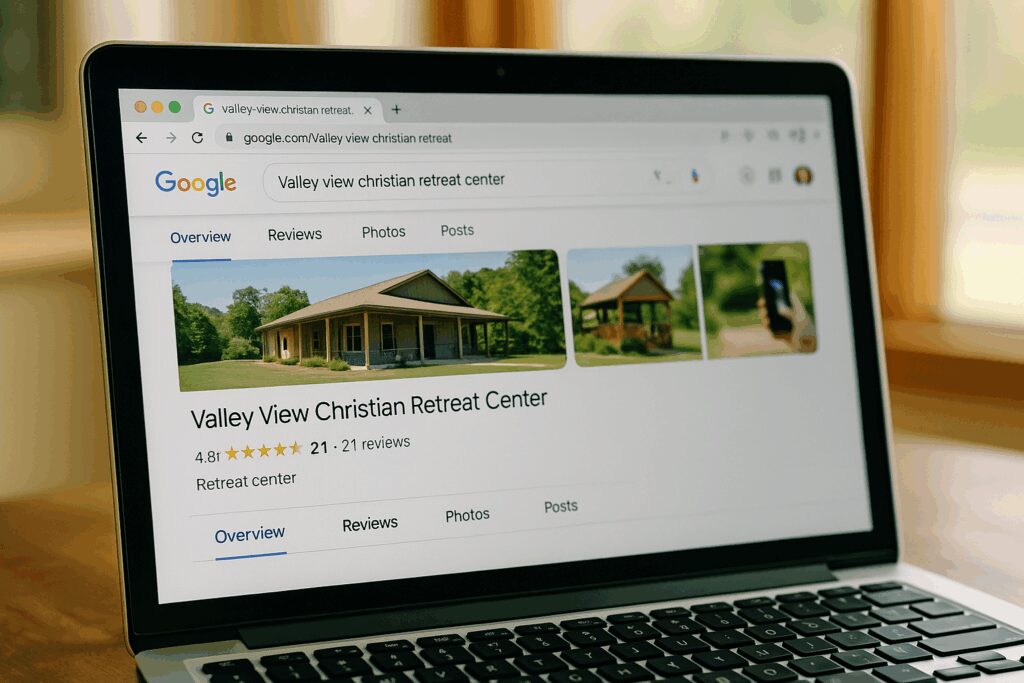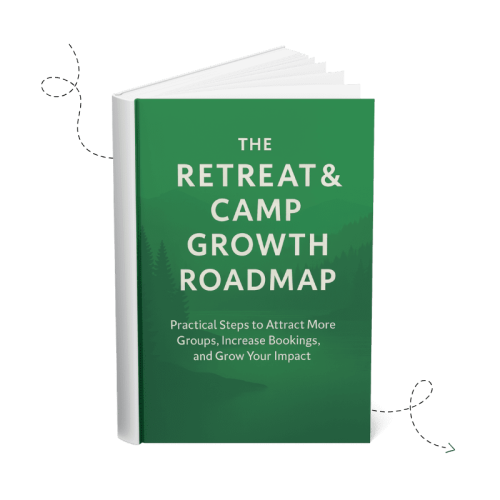Retreat & Camp Growth Roadmap Focus Area: Start Local SEO
Introduction
If you want more groups to find your camp or retreat center, it’s not enough to simply have a website—you need to show up where they’re already searching. That’s what Local SEO (Search Engine Optimization) does: it helps your ministry appear in local search results, especially for planners looking for venues near them.
When someone types “retreat center near me” or “summer camp in [your town],” a strong local SEO strategy helps ensure your center is part of that conversation. This isn’t about chasing trends or complicated tech—it’s about practical stewardship: keeping your digital front door in order so your community can find and trust you.
Why This Focus Area Matters
Local SEO is one of the most reliable ways to connect with new guest groups—especially churches, schools, and ministries planning events in your region. Unlike broad marketing campaigns, local SEO connects you with people who are actively looking for a place like yours right now.
Research shows that over 90% of people use search engines to find new solutions, services, or venues, and in many industries—including hospitality and events—organic search drives 50% or more of total website traffic. This makes Local SEO a critical channel to prioritize if you want to be visible when it matters most.
Here’s why it matters:
- It builds trust – A polished, consistent presence signals credibility.
- It expands your reach – You’ll show up for new groups searching beyond your current network.
- It supports stewardship – Many local SEO tools are free, like Google Business Profile.
- It attracts qualified inquiries – You connect with planners already seeking to book an event.
In short, local SEO helps your retreat center show up, speak clearly, and stay visible without exhausting your team.
Is This an Area You Need to Focus on Right Now?
Consider your current local presence:
- Is your Google Business Profile regularly updated with accurate details and fresh content?
- Do you receive and respond to guest reviews consistently?
- Does your website mention the cities, regions, or group types you serve?
- Are you publishing content that speaks to local or regional planners?
- Do you appear on the first page of Google for important keywords like “retreat center near [your location]”?
- Does Organic Search represent 50% or more of your current website traffic?
If you answered “no” to any of these, this focus area can help you bring greater clarity, alignment, and impact to your outreach.
Putting This Focus Area into Practice
Once your website, Google listing and directory profiles are live, the next step is keeping them active and relevant. Here’s a practical step-by-step approach.
Maintaining & Expanding Your Online Presence
Keep Your Google Business Profile Active and Accurate
Your Google Business Profile is often the very first impression planners have of your retreat center—sometimes before they ever see your website. Treat it like your public-facing welcome desk. Research shows that Google Business Profiles can capture 15–20% of all clicks for local searches, meaning this single listing can drive a significant share of your inquiries. An active, well-managed profile not only signals professionalism to potential guests but also sends strong trust signals to search engines that can boost your visibility.
- Review and update your listing quarterly—contact info, descriptions, hours, and categories should be accurate and consistent with your website.
- Post weekly about availability, seasonal programs, new amenities, or recent event highlights.
- Upload fresh, high-quality images of events, facilities, and scenery to keep your visual presence vibrant.
- Respond to public Q&A promptly and professionally to build trust with prospective guests.
By keeping your profile active and accurate, you’re telling both people and search engines that your retreat center is engaged, relevant, and ready to serve—making it one of the simplest and most effective ways to improve local visibility and credibility. For more detailed strategies on optimizing this powerful tool, see our this blog article.

Other Existing Listings and Profiles
Your Google Business Profile is key, but it’s only one part of your online presence. Review all existing listings on social media platforms, national directories, industry-specific sites, niche networks, and local business directories at least once a year to ensure information is accurate and consistent across all platforms.
In addition, conduct representative searches for your target keywords (e.g., “Christian retreat center in [region]” or “summer camp near [city]”) to identify new directory or listing opportunities that may have emerged. This could include local tourism sites, chamber of commerce directories, or faith-based event planning networks.
Maintaining and expanding your presence across a variety of relevant platforms reinforces your credibility, ensures accuracy, and helps you reach potential guests who prefer different search or discovery channels. For more information on managing your directory listings and links to lots of free directory opportunities, read this blog article.
Manage and Leverage Guest Reviews
Reviews are modern-day word-of-mouth, and their influence is powerful—studies show that over 85% of consumers read or rely on reviews before making a purchase or booking decision. For retreat centers, strong, recent reviews can be the deciding factor for a group planner comparing multiple venues. Managing reviews well means both actively collecting them and thoughtfully responding to each one.
Review Platforms to Prioritize
While there are many places guests can leave reviews, Google should be your top priority. Aim for at least 10 reviews on your Google Business Profile as an initial milestone—this helps establish credibility quickly. Every review after that counts, especially because fresh reviews are a major ranking factor. Facebook and Yelp are also important, as well as industry-specific platforms like TripAdvisor. The best practice is to grow reviews across multiple platforms so you’re visible wherever potential guests may be looking. Tools like LeadHub make it easier to direct guests to specific platforms or rotate which platforms are suggested, helping balance your review profile.
How to Request Reviews Effectively
An intentional approach to asking for reviews can dramatically improve both the quantity and quality of feedback you receive. Here are strategies to use:
- Post signs with QR codes in high-traffic areas of your property, making it easy for guests to scan and leave a review before they leave.
- Verbally request reviews at the end of an event when satisfaction is high. A warm, personal request can go a long way.
- Send follow-up emails thanking guests for their visit and including a direct Google review link with simple instructions.
- Automate requests with tools like LeadHub, which can send initial review invitations and schedule friendly follow-ups via both email and SMS to boost response rates.
- Craft your wording thoughtfully—express gratitude for their visit, emphasize the importance of their feedback to help future guests, and make the process sound quick and easy.
Asking for reviews isn’t just about boosting your star rating—it’s about creating a consistent flow of authentic guest feedback that builds your credibility over time and strengthens your visibility across multiple channels.
Responding to Guest Reviews
Responding to reviews—both positive and negative—is just as important as collecting them. Every response is a public demonstration of your hospitality and professionalism.
Guidelines for Responding:
- Reply to every review within a few days, showing attentiveness.
- Positive reviews: Thank the guest warmly, highlight something specific they mentioned, and express your hope to welcome them back.
Example: “Thank you, Sarah, for your kind words about our team-building program. We loved having your group here and hope to see you again next year!” - Negative reviews: Acknowledge their concern, apologize if appropriate, and offer a path for resolution without being defensive.
Example: “We’re sorry to hear parts of your stay didn’t meet expectations. We appreciate your feedback and would love the chance to discuss how we can make things right—please reach out to us directly at [contact info].”
When you respond with humility, gratitude, and a solutions-oriented tone, you show prospective guests that you value feedback and are committed to exceptional service. Third-party tools like LeadHub can even help streamline this process by suggesting or generating appropriate responses based on the sentiment of each review, saving time while ensuring your replies remain thoughtful and on brand.
Optimize Your Existing Website Content for Local Search Visibility
Google’s algorithm tends to prioritize local websites for local searches, making it especially important that your site clearly communicates its location and relevance to your community. Studies show that websites ranking in the first organic position can capture roughly 24% of clicks for a given search, meaning that visibility here can directly translate into inquiries and bookings for your retreat or camp.
Your site should tell both search engines and people that you’re a trusted local ministry and a relevant option for their needs.
- Ensure that relevant keywords are utilized on your homepage and other key pages
- Incorporate city, region, or state names naturally to your homepage and key landing pages.
- Include your full address and a link to your Google Business Profile in the footer.
- Embed your Google Map listing & Google Reviews
- Make sure your website is mobile-friendly
- Implement local business schema markup (a web developer can help with this)
- Make sure the website is mobile-friendly
By intentionally optimizing your website for local search, you increase your chances of appearing on that critical first page—and in turn, in front of the planners most likely to book. These updates not only boost rankings but also enhance trust and make it easier for your ideal audience to take the next step.
Create New Content to Expand Local Search Visibility
Creating new, relevant content is one of the most effective ways to expand your local search visibility. Every new page or post gives search engines another opportunity to understand your location, services, and relevance to local audiences. Below are core content types to develop, along with guidance for each.
Service-Specific Pages
Add a dedicated page for each service you provide—such as retreats, camps, events, or specialty programs. These pages should clearly explain the service, include location-specific keywords, and feature photos and testimonials. Each page acts as a landing point for searchers looking for that exact service in your area.
Facility Feature Pages
Highlight key aspects of your facilities with their own pages—meeting rooms, lodging, recreation areas, or dining facilities. Describe amenities, capacities, and unique features, and incorporate location references to strengthen local relevance.
Service Area & Location Pages
Include an “Our Service Area” page to show where you serve, listing relevant towns, cities, or counties, and incorporating local landmarks or travel routes. For high-traffic areas, create specific location pages—such as “Summer Camps in [Town Name]”—with localized content, examples of events in that area, and links to related services.
Helpful Blog Content
Publish blog posts that address questions and needs of your target audience, tailored to your region. This can include seasonal tips, planning guides, and features on local attractions or partners. Consistent, high-quality blog content can position you as an authority and draw ongoing local traffic.
Adding Local Context to Other Pages
Integrate local details across your entire website—not just blogs. Include references to your community, service area, and nearby landmarks in program descriptions, the About page, and even your Contact page.
By systematically building out these content types, you create multiple entry points for both search engines and potential guests to find and connect with you. A steady flow of helpful, localized content not only boosts your SEO rankings but also deepens trust with the community you serve.
Use Location-Based Image Optimization
Images aren’t just decorative—they can play a significant role in your SEO strategy. Well-optimized images can improve your visibility in image searches, strengthen your local relevance, and enhance the overall user experience on your site. For Local SEO, they also provide valuable location cues to search engines, reinforcing your connection to a specific region.
Geotag Your Photos
Before uploading to your website or Google Business Profile, add geotags to your images so they carry location metadata. You can use free tools like GeoImgr to do this quickly. This helps search engines associate your images with your exact location.
Use Descriptive Filenames
Instead of generic filenames like IMG1234.jpg, use names that clearly describe the scene and include the location, such as mens-retreat-virginia-mountains.jpg. This improves the image’s discoverability and relevance.
Write Location-Rich Alt Text
Alt text should describe the content of the image while naturally incorporating local context. For example: “Guests enjoying an outdoor worship service at sunset in the Shenandoah Valley.” This not only helps with accessibility but also signals location relevance to search engines.
By taking these steps, you’re turning each image into another local SEO asset. When consistently applied, image optimization can help your retreat or camp stand out visually in search results while reinforcing your geographic presence.

Track and Measure Your Results
To know if your Local SEO efforts are truly paying off, you need to track performance consistently and review your data with intention. Without regular measurement, you may miss opportunities to double down on what’s working—or fix what’s not.
Google Business Profile Insights
Your Google Business Profile (GBP) Insights provides valuable real-time data about how people are finding and interacting with your retreat center’s profile. You can track:
- How many people discovered you through direct searches (typing your name) versus discovery searches (searching “retreat center near me”).
- How many profile and photo views you’ve received over time.
- The number of actions taken—calls, website visits, and direction requests—directly from your listing.
These metrics help you see which updates—such as posting new photos, publishing weekly updates, or responding to reviews—are driving the most engagement. If you notice a spike in profile activity after adding seasonal event posts, you can make that a regular practice.
Google Analytics
Google Analytics (GA) is your go-to tool for understanding what visitors do once they land on your website. It lets you:
- Measure organic search traffic growth over time so you can see if your SEO efforts are increasing visits from Google.
- Identify which pages and blog posts are attracting the most traffic—and which ones need improvement.
- Track goal completions like inquiry form submissions, phone clicks, or downloads of your retreat planning guide.
- See which devices and browsers visitors are using, helping ensure your site is delivering a good experience everywhere.
By monitoring these metrics, you can focus on the content and pages that actually lead to inquiries and bookings, rather than chasing vanity traffic numbers.
Google Search Console
Google Search Console (GSC) provides direct feedback from Google on how your site appears in search results. It allows you to:
- See which keywords and search phrases are driving people to your website.
- Monitor your site’s average position for important local SEO terms.
- Identify any technical SEO issues like crawl errors, mobile usability problems, or missing structured data.
- Submit updated sitemaps to ensure new pages are indexed quickly.
GSC is especially valuable for spotting new keyword opportunities. For example, if you notice you’re appearing for “youth retreat in [region]” but not ranking high, you can optimize a page or create new content to target that term more directly.
Monthly Performance Review
Make it a habit to review these three data sources monthly. Look for trends and patterns, not just one-time spikes or dips. For example:
- If Google Business Profile interactions jump after adding new event photos, repeat that quarterly.
- If Google Analytics shows a blog post generating a steady stream of visitors, create similar content targeting related topics.
- If Google Search Console shows you ranking on page two for a valuable keyword, optimize your existing page to push it higher.
When you track and act on this data consistently, your Local SEO strategy becomes more focused, effective, and rewarding over time.
Local SEO Readiness Checklist
A strong local search presence doesn’t happen by accident—it’s the result of consistent, intentional work. This checklist is designed to help your retreat center or camp translate the strategies in this article into a practical, step-by-step plan you can follow month after month.
Inside, you’ll find every key action item covered above, from keeping your Google Business Profile updated and gathering reviews, to optimizing your website for local searches and creating region-focused content. Each task is broken down into clear, trackable steps so you can easily assign responsibilities, monitor progress, and stay on top of recurring activities.
Whether you’re just getting started with Local SEO or refining an existing strategy, this checklist will help you:
- Build a consistent rhythm for maintaining your online presence
- Avoid overlooking critical tasks that impact your rankings
- Track your progress over time to see which actions are producing results
- Keep your team aligned and accountable
📥 Download the Local SEO Readiness Checklist
Consistency is the key to seeing long-term growth in search visibility and inquiries. By working through this checklist on a regular schedule, you’ll ensure your local presence stays strong, your content stays relevant, and your retreat center is always easy to find for the people you’re trying to reach.

Mini Case Study
Refreshing Mountain Retreat & Adventure Center, a long-time client, is a strong example of what consistent Local SEO can accomplish. Through a strategic focus on optimizing their Google Business Profile, earning and responding to guest reviews, creating regionally relevant content, and improving on-page SEO, they steadily improved their online visibility. Over time, this consistent effort led to dramatic growth—from approximately 100 inquiries per year to over 1,200 annually. This growth did not happen overnight, but rather through disciplined, ongoing optimization that built momentum and credibility year after year. You can read the full story, including more details on the SEO work and results, in our Refreshing Mountain case study.
Putting It All Together
Local SEO is a rhythm, not a one-time project. Regular updates, review requests, localized content, and site optimization build visibility that compounds over time.
Practical takeaways you can start this month:
- Schedule a weekly block of time to post content on your Google Business Profile
- Develop a plan for requesting reviews after every event, including follow up via email or text
- Monitor your key profiles for new reviews and respond to every one
- Add local keywords to your homepage and key pages.
- Create a “Service Area” page listing your region and nearby cities.
- Map out a plan to write localized blog postsfor a specific audience.
Start with what’s manageable, build habits, and let consistency do the heavy lifting.
Many retreat centers and camps that commit to these practices—whether in-house or with expert help—see returns far beyond their initial investment. In our experience, it’s not uncommon for a well-run local SEO strategy to generate a 10X or greater return in new inquiries and bookings.
Ready to Take the Next Step?
Taking ownership of your local SEO presence helps your ministry get found by the right groups, at the right time—without needing a large marketing budget.
If you found this helpful, here are four great next steps to continue your journey:
🧭 Move to the Next Focus Area: Create Landing Pages
Learn how to create landing pages and ad campaigns that reach planners actively searching for retreat venues like yours.
[Read Create Landing Pages]
📘 Download the Retreat & Camp Growth Roadmap eBook
Get the full 3-stage system we use to help Christian retreat centers and camps grow with clarity and purpose.
[Download the eBook]
🌱 Learn More About How We Help Retreat Centers & Camps
We’re a Christian-owned marketing agency that helps ministries grow attendance, bookings, and impact through practical strategies rooted in clarity and stewardship.
[See How We Can Help]
🤝 Schedule a Free Discovery Call
Want help applying this to your unique situation? Let’s talk. We’ll explore where you are now, where you want to go, and how to take the next faithful step.
[Book a Discovery Call]
You don’t have to figure this out alone. Let’s build something meaningful—together.
Frequently Asked Questions
1. What exactly is Local SEO?
Local SEO is the targeted process of improving your visibility in search results for people in your geographic area, ensuring you appear prominently when potential guests are actively looking for a venue nearby. For retreat centers, that means earning a spot in those high-value results when someone searches for terms like “Christian retreat center near me” or “summer camp in [your state].” It involves optimizing your website, Google Business Profile, and online presence so that search engines recognize you as a trusted, relevant choice for your local market. Done well, Local SEO doesn’t just increase visibility—it connects you with qualified planners at the exact moment they’re ready to engage.
2. How is Local SEO different from regular SEO?
Regular SEO focuses on ranking in national or global search results, while Local SEO targets people searching within a specific area. The strategies are similar but Local SEO relies more on maps listings, directory profiles, and geographically relevant content.
3. How much time should I spend on Local SEO each month?
For most retreat centers, a few hours per week can be enough to maintain and improve local visibility, but you’ll also need to dedicate time to learning SEO fundamentals and staying current with best practices. This could mean reading SEO blog articles, watching training videos, or even taking online courses. Our own Retreat & Camp Marketing Blog is a great place to start. The key is consistency—set a schedule for updates, content creation, and review requests, and pair that with ongoing learning so your efforts remain effective and up to date.
4. Do I need a professional to manage Local SEO?
Not necessarily. You can absolutely manage Local SEO on your own, but it will require dedication to learning the fundamentals, keeping up with best practices, and making a consistent investment of time each month. Many of the most impactful steps—like updating your Google Business Profile or requesting reviews—can be handled in-house. That said, working with a professional who does this for a living can save time, ensure technical details are implemented correctly, and often accelerate results. In our experience, many retreat centers that partner with an industry-experienced SEO professional see returns of 10X or more, but it’s important to choose someone who understands the unique needs and challenges of your ministry or camp.
5. Are there any tools I can use to manage Local SEO on my own?
Yes. We recommend LeadHub CRM, which includes features specifically built for Local SEO, such as directory listing management, review management, and tools for managing your Google Business Profile—including the ability to schedule weekly posts. LeadHub CRM also offers broader marketing capabilities like email marketing, social media marketing, and marketing automation, making it a well-rounded platform for retreat centers.
6. How quickly will I see results?
You can often see signs of improvement in your Local SEO within just a few weeks—things like slight ranking increases or more impressions in search results. However, meaningful progress in traffic growth typically takes 2–3 months, and measurable increases in inquiries often take 6–9 months. The good news is that once you begin seeing progress, it tends to accumulate quickly and build year over year. For example, one retreat center we work with grew from 100 inquiries annually to over 1,200 by maintaining consistent Local SEO efforts. You can read more about their story in our Refreshing Mountain case study.
7. Can Local SEO help during my off-season?
Yes. Local SEO connects you with groups searching year-round, including off-peak times. Highlighting seasonal availability in your listings and content can help fill slower months.
8. What’s the role of reviews in Local SEO?
Reviews are both a ranking factor and a trust signal. More positive reviews (and prompt responses) improve your chances of appearing higher in local results and convincing planners to inquire.
9. What happens if I ignore Local SEO?
Without attention to Local SEO, you risk being invisible to groups who don’t already know about you. Even with strong word-of-mouth, you’ll miss opportunities from planners starting their search online.





